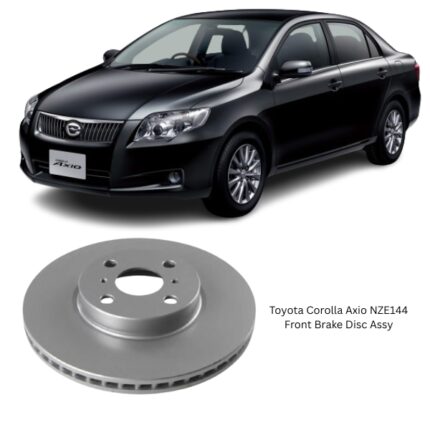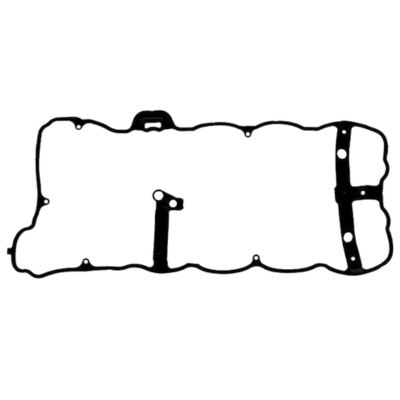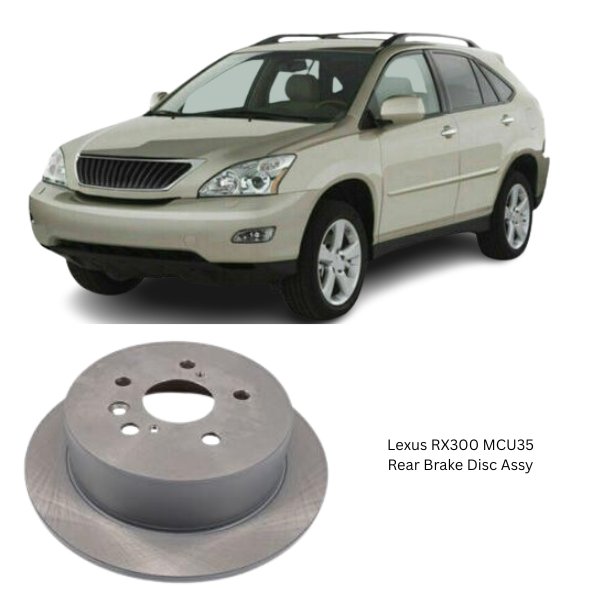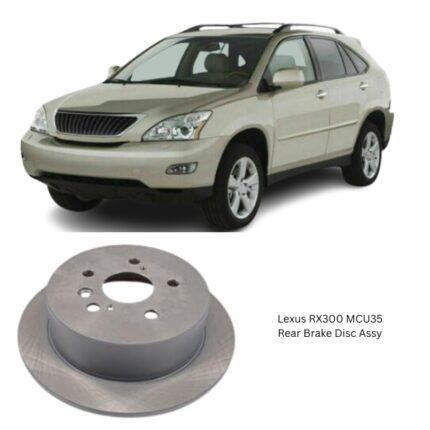Get Lexus RX300 MCU35 Rear Brake Disc Assy 42431-48050 in Kenya
The Rear Brake Disc Assembly is a vital component of the modern automotive braking system, specifically responsible for managing braking forces at the rear axle. While front brakes typically handle a larger share of the stopping workload due to forward weight transfer during deceleration, rear brakes play a crucial role in vehicle balance, stability, and overall braking efficiency.
Functioning as a central element of the disc brake setup at the rear axle, the brake disc (also referred to as a rotor) provides a precise and smooth surface for brake pad engagement. The resulting friction between the pads and the disc allows the vehicle to decelerate safely and predictably, while also contributing to heat dissipation and consistent brake modulation.
Structural Overview
The Rear Brake Disc Assembly comprises several integral parts that work together to deliver reliable performance:
-
Brake Disc (Rotor)
The primary rotating friction surface, mounted securely to the wheel hub and rotating with the wheel. During braking, calipers clamp the brake pads onto this disc, creating the necessary friction for deceleration. -
Mounting Face
The section of the disc that mates with the hub flange. It includes precise machining for bolt holes or a center bore, ensuring concentricity and secure attachment to the wheel hub. -
Friction Faces
The outer surfaces of the disc on which the brake pads act. These faces must be flat, true, and uniformly machined to prevent vibration and uneven wear. -
Ventilation Channels (where applicable)
Found between the inner and outer friction surfaces in vented discs, these internal vanes allow airflow to help dissipate heat, which is particularly beneficial during extended braking.
Rear brake discs may come in solid or vented configurations. Solid rotors are common in lighter-duty applications, while vented rotors are used in heavier or high-performance vehicles where thermal management is more critical.
Material Composition
Rear brake discs are typically manufactured from cast iron, prized for its thermal conductivity, strength, and resistance to wear and cracking under high heat. Some rotors are made with high-carbon cast iron to improve heat dissipation, reduce vibration, and minimize noise. Other variants may include anti-corrosive coatings such as zinc plating or phosphate finishes, which prevent rust formation and maintain structural integrity over time.
Advanced applications may utilize composite materials like carbon-ceramic or carbon-carbon composites, offering lightweight construction and excellent performance under extreme conditions. These are usually reserved for motorsport or specialized braking systems.
Operational Function
When the brake pedal is engaged, hydraulic pressure activates the rear brake calipers, pushing the brake pads against both sides of the spinning disc. The resulting friction slows the disc’s rotation and, consequently, the rotation of the wheel attached to the hub.
The rear brake disc must perform this task under varying load conditions and during diverse driving scenarios, including descending hills, stop-and-go traffic, and emergency braking. Effective rear brake disc performance ensures:
-
Even braking distribution
-
Minimized stopping distance
-
Vehicle stability
-
Enhanced safety during cornering or evasive maneuvers
Rear disc brakes also improve parking brake function in systems where the handbrake uses the same caliper assembly or an integrated drum-in-hat design for the emergency brake.
Thermal Characteristics and Performance
Rear brake discs are engineered to endure significant thermal stress. Though they often deal with less heat than front rotors, they still require robust construction to avoid:
-
Heat-induced warping
-
Brake fade
-
Surface glazing
-
Thermal cracking
The design and mass of the rotor directly affect its thermal capacity. Vented discs, which contain internal vanes or directional fins, permit air to flow between the rotor faces to dissipate heat rapidly. These vanes may be straight, curved, or pillar-type, depending on design and application.
Brake Disc Surface Features
Brake discs may incorporate various design elements to enhance performance:
-
Drilled holes: Aid in gas evacuation and cooling but may increase the risk of cracking under extreme load.
-
Slots or grooves: Channel away water, brake dust, and gases, improving pad bite and wet-weather performance.
-
Dimpled faces: Offer some benefits of drilled rotors without compromising structural strength.
These surface treatments also contribute to noise reduction, brake feel, and resistance to fade over long braking intervals.
Wear and Maintenance
Like all friction-related components, the rear brake disc experiences wear over time. Key indicators of wear include:
-
Scoring or grooving: Caused by debris or excessive pad wear.
-
Surface discoloration: Blueing or heat marks indicate overheating.
-
Cracks or micro-fractures: Signs of thermal stress or improper torque during installation.
-
Thickness variation (DTV): Uneven pad contact, often causing brake pulsation or vibration.
Regular inspection of the disc’s condition is vital. Most rotors have a minimum thickness specification stamped on the rotor hat or outer edge. If the rotor wears below this value, replacement is required to maintain braking efficiency and safety.
Resurfacing is possible for lightly worn rotors, provided they remain above minimum thickness after machining. However, modern replacement rotors are often preferred over machining due to cost efficiency and the precision needed.
Installation Considerations
Proper installation ensures the brake disc’s longevity and performance. Key steps include:
-
Surface cleaning: Any factory-applied anti-corrosion oil must be removed with brake cleaner before use.
-
Hub preparation: Remove rust, dirt, or debris from the hub face to prevent runout and ensure full contact.
-
Bolt torque sequence: Even and accurate torquing prevents disc distortion or misalignment.
-
Rotor runout measurement: Ensures disc does not wobble, which can lead to noise and uneven pad wear.
When installing new discs, it is strongly recommended to replace brake pads simultaneously and bed them in correctly for optimal friction surface conditioning.
Common Failure Modes
Rear brake discs can fail or degrade in several ways, including:
-
Warping: Caused by uneven heating, over-torquing, or improper pad bedding.
-
Corrosion: Leads to surface pitting and diminished friction performance.
-
Cracking: Often occurs on slotted or drilled rotors subjected to severe thermal cycling.
-
Excessive wear: Reduces rotor mass and compromises braking efficiency.
Proactive maintenance and the use of high-quality pads and fluids help extend the service life of the rear brake disc assembly.
Follow us on Facebook for more parts.





Reviews
Clear filtersThere are no reviews yet.